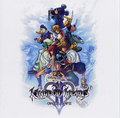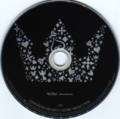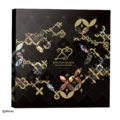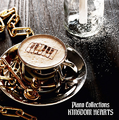Kingdom Hearts II Working Together
Arranger
Yoko Shimomura
Composer
Yoko Shimomura
Length
1:30
Kingdom Hearts Birth by Sleep Working Together
Arranger
Yoko Shimomura
Composer
Yoko Shimomura
Kingdom Hearts HD 2.5 ReMIX Working Together
Arranger
Yoko Shimomura
Composer
Yoko Shimomura
Length
2:33
Kingdom Hearts III Working Together -KINGDOM HEARTS III Version-
Arranger
Natsumi Kameoka
Composer
Yoko Shimomura
Orchestrator
Natsumi Kameoka
Length
2:44
Piano Collections Kingdom Hearts Finale : Working Together - Allegro vivace
Arranger
Miwa Sato
Composer
Yoko Shimomura
Length
3:31
"Working Together " is a musical composition by Yoko Shimomura that appears in the Kingdom Hearts seriesTwilight Town and the battle theme of The Mysterious Tower .
Appearances "Working Together" is the battle theme of Twilight Town in Kingdom Hearts II Kingdom Hearts III Kingdom Hearts II and Kingdom Hearts Birth by Sleep
Kingdom Hearts II Mysterious Tower: "My Name is Pete" Kingdom Hearts III Twilight Town: "Nostalgic Streets", "A Forager in Distress" Composition "Working Together" is approximately one minute and thirty seconds long in Kingdom Hearts II . In the HD remake, it is extended to two minutes and thirty-three seconds. For the piano collections version, the piece is approximately three minutes and thirty-one seconds long. Regardless of the game, the piece has a time signature of 4/4. For tempo, in Kingdom Hearts III and the piano collections version, the piece has a tempo of 155 beats per minute; this is the "slowest" version of the piece throughout the series. In Kingdom Hearts II , the tempo is 157 beats per minute. In Kingdom Hearts Birth by Sleep , and Kingdom Hearts HD 2.5 ReMIX , the tempo is very slightly increased to 158 beats per minute.
For instrumentation, each version uses similar instruments, though for games not in the HD remakes or Kingdom Hearts III , some voices are covered through electronic means- such as synthesizer. In general, the instrumentation includes: a complete strings section- violin, viola, cello, and stringed bass, piccolo, flute, oboe, French horn, trumpet, trombone, tuba, timpani, triangle, tambourine, crash cymbals, snare drum, orchestral bells, marimba, harp, and piano.
As expressed in the piano collection version's title, "Working Together" is a lively piece. "Allegro vivace" roughly translates to a tempo that is noticeably faster than an allegro tempo, but is played in a quick and lively tempo customary to the vivace tempo marking. The piece starts with reduced instrumentation, with the strings playing the main melodic line in the pizzicato style. Underlying this plucked melody is a rhythmically driving snare drum part, emphasis on the dominate beat in timpani and low brass voices, and minor interplay between the triangle and tambourine. Following this brief introduction is the piccolo, playing a fast almost grace-note-like run that transitions the piece into the longer, fully orchestrated theme.
This new theme lasts for sixteen measures, in which the originally melody initially introduced by the strings is shared between the various mallet percussion and woodwind instruments. During this feature, the lower voiced brass and pitched percussion instruments play a continued eighth-note rhythmic figure that slightly resembles the low brass part in Neverland Sky .
Promptly following the second theme is a more connected, legato-style melody, which is a variant of "Dearly Beloved ". Here, at such a tempo and use of rhythms, the piece can be felt in the established fast 4/4, or, more preferably, in half-time. Throughout the piece, certain instrument-specific techniques are used, such as: pizzicato style in the strings, multiple tonguing- in this case, double tonguing- in the trumpets, and use of rolls for mallet percussion. The piano collections version features a variety of ornamentations and key changes to add to the "elaborate" or "lively" nature. Likewise, the piano version shares the melody sporadically between the bass and treble voices.
Albums See also
Music in the Kingdom Hearts series
Main themes
Dearly Beloved | Destati Chikai | Don't Think Twice | Face My Fears | Hikari | Passion | Sanctuary | Simple and Clean Hikari -PLANITb Remix- | Hikari -Ray of Hope MIX- | Passion -after the battle- | Passion -opening version- | Sanctuary -after the battle- | Sanctuary -opening version- | Simple and Clean -PLANITb Remix- | Simple and Clean -Ray Of Hope MIX- Don't Think Twice -KINGDOM Orchestra Instrumental Version- | Face My Fears -KINGDOM Orchestra Instrumental Version- | Hikari -KINGDOM Orchestra Instrumental Version- | Passion -KINGDOM Orchestra Instrumental Version-
Music introduced in Kingdom Hearts
A Day in Agrabah | A Piece of Peace | A Very Small Wish | A Walk in Andante | Always on My Mind | An Adventure in Atlantica | An Intense Situation | Arabian Dream | Beyond the Door | Blast Away! -Gummi Ship I- | Blast Away! -Gummi Ship II- | Blast Away! -Gummi Ship III- | Bounce-O-Rama | Bustin' Up on the Beach | Captain Hook's Pirate Ship | Deep Jungle | Destiny Islands | Destiny's Force | Dive into the Heart -Destati- | End of the World | Forze del Male | Fragments of Sorrow | Friends in My Heart | Go for It! | Guardando nel buio | HIKARI -KINGDOM HEARTS Instrumental Version- | Hand in Hand | Hand in Hand -Reprise- | Having a Wild Time | Hollow Bastion | Holy Bananas! | It Began with a Letter | Just an Itty Bitty Too Much | Kairi I | Kairi II | Kairi III | March Caprice for Piano and Orchestra | Merlin's Magical House | Mickey Mouse Club March | Miracle | Monstrous Monstro | Never Land Sky | Night of Fate | No Time to Think | Olympus Coliseum | Once Upon a Time | Oopsy-Daisy | Pirate's Gigue | Precious Stars in the Sky | Road to a Hero | Scherzo Di Notte | Shipmeisters' Humoresque | Shrouding Dark Cloud | Spooks of Halloween Town | Squirming Evil | Strange Whispers | The Deep End | The Heartless Has Come | This is Halloween | To Our Surprise | Traverse Town | Treasured Memories | Tricksy Clock | Turning the Key | Under the Sea | Villains of a Sort | Welcome to Wonderland | Where Is This? | Winnie the Pooh A Night on Bald Mountain | One-Winged Angel (from FINAL FANTASY VII)
Music introduced in Kingdom Hearts Final Mix
Another Side | Disappeared
Music introduced in Kingdom Hearts Chain of Memories
Castle Oblivion | Disquieting | Face It! | Forgotten Challenge | Graceful Assassin | Just Wondering | La Pace | Lazy Afternoons | Memories in Pieces | Naminé | Piccolo Resto | Revenge of Chaos | Scent of Silence | Scythe of Petals | Sinister Sundown | Struggle Away | The 13th Floor | The 13th Struggle | The Fight for my Friends | The Force in You | Thirteenth Discretion
Music introduced in Kingdom Hearts Re: Chain of Memories
Dash-A-Long | Lord of the Castle | March-A-Long
Music introduced in Kingdom Hearts II
A Fight to the Death | A New Day is Dawning | A Twinkle in the Sky | Adventures in the Savannah | Any Time Any Place | Apprehension | Arabian Daydream | Asteroid Attack | Battleship Bravery | Beauty and the Beast | Beneath the Ground | Blast Off! | Bounce-O-Rama (Speed Up Ver.) | Byte Bashing | Byte Striking | Cloudchasers | Courage | Crossing the Finish Line | Dance of the Daring | Dance to the Death | Darkness of the Unknown | Deep Drive | Desire for All That Is Lost | Fantasia alla marcia for piano, chorus and orchestra | Fields of Honor | Floating In Bliss | Gearing Up | Hazardous Highway | He's a Pirate | Hesitation | Isn't It Lovely? | Kairi | Laughter and Merriment | Let's Sing and Dance! | Magical Mystery | Missing You | Monochrome Dreams | Nights of the Cursed | Old Friends, Old Rivals | Organization XIII | Part of Your World | Reviving Hollow Bastion | Riku | Rowdy Rumble | Roxas | Sacred Moon | Savannah Pride | Shipmeisters' Shanty | Showdown at Hollow Bastion | Sinister Shadows | Sora | Space Paranoids | Sunset Horizons | Swim This Way | Tension Rising | The 13th Dilemma | The Afternoon Streets | The Corrupted | The Encounter | The Escapade | The Home of Dragons | The Underworld | The Wonderful Thing About Tiggers | Ursula's Revenge | Vim and Vigor | Waltz of the Damned | What Lies Beneath | Working Together
Music introduced in Kingdom Hearts II Final Mix
Cavern of Remembrance | Deep Anxiety | Fate of the Unknown | Happy Holidays! | Rage Awakened | The 13th Reflection | The Other Promise | What a Surprise?!
Music introduced in Kingdom Hearts 358/2 Days
Another Side -Battle Ver.- | At Dusk, I Will Think of You... | Critical Drive | Crossing to Neverland | Fight and Away | Musique pour la tristesse de Xion | Mystic Moon | Results and Rewards | Secret of Neverland | Vector to the Heavens | Xemnus
Music introduced in Kingdom Hearts coded
On the Debug!!
Music introduced in Kingdom Hearts Re:coded
No More Bugs!! | No More Bugs!! -Bug Ver.- | Pretty Pretty Abilities | Wonder of Electron | Wonder of Electron -Bug Ver.-
Music introduced in Kingdom Hearts Birth by Sleep
A Date with Fate | Aqua | Bibbidi-Bobbidi-Boo | Big Race | Birth by Sleep -A Link to the Future- | Black Garden | Black Powder | Castle Escapade | Cheers for the Brave | Daydream upon Neverland | Dearly Dreams | Dessert ★ Paradise | Destiny's Union | Dice and Shine | Dismiss | Drops of Poison | Enter the Darkness | Enter the Void | Eternal Moments | Extreme Encounters | Fresh Fruits Balls | Future Masters | Go! Go! Rumble Racer | Hau'oli, Hau'oli | Hero or Heel? | Innocent Times | It's a Small World | Keyblade Graveyard Horizon | Mickey Mouse March | Mákaukau? | Neverland's Scherzo | Peaceful Hearts | Radiant Garden | Rage Awakened -The Origin- | Risky Romp | Shaded Truths | Tears of the Light | Terra | The Key | The Key of Darkness | The Key of Light | The Promised Beginning | The Rustling Forest | The Secret Whispers | The Silent Forest | The Tumbling | The Worlds | Unbreakable Chains | Unforgettable | Up Down Adventure | Ventus | Xehanort
Music introduced in Kingdom Hearts Birth by Sleep Final Mix
Dark Impetus | Forze dell'Oscurita | Hunter of the Dark | Master, Tell Me the Truth | Monstrous Monstro -Arena Ver.- | Night in the Dark Dream | Night of Tragedy
Music introduced in Kingdom Hearts 3D: Dream Drop Distance
Access the Grid | All for One | Broken Reality | CALLING -KINGDOM MIX- | Deep Drop | Digital Domination | Distant from You... | Dream Drop Distance -The Next Awakening- | Dream Eaters | Dream Matchup | Ever After | Gigabyte Mantis | Hand to Hand | Ice-hot Lobster | Keyblade Cycle | L'Apprenti Sorcier L'Eminenza Oscura I | L'Eminenza Oscura II | L'Impeto Oscuro | L'Oscurità dell'Ignoto | La Cloche | Le Sanctuaire | Link to All | Majestic Wings | My Heart's Descent | One for All | Prankster's Party | Ready to Rush | Rinzler Recompiled | SOMEDAY -KINGDOM MIX- | Sacred Distance | Storm Diver | Sweet Spirits♡ | Symphony No.6 "Pastoral" Op.68 TWISTER -KINGDOM MIX- | The Dread of Night | The Dream | The Eye of Darkness | The Flick Finalist | The Fun Fair | The Nightmare | The Nutcracker Suite Op.71 The World of Dream Drops | Traverse in Trance | UNTAMABLE | Victor's Pride | Wild Blue | Xehanort -The Early Years- | Xigbar
Music introduced in Kingdom Hearts χ[chi]
Before the Daylight | Wake Up, World!
Music introduced in Kingdom Hearts Union χ[Cross]
A Nameless Planet | Battle at the Big Bridge | Dancing Mad | Game Central Station | Hand in Hand -Union χ Version- | Hero's Duty Troopers | I'm Gonna Wreck It! | Mission Complete! | Pixel Hero | The Candy-Filled Kingdom | The Fastest Racer | TWISTER -UNION χ MIX- | Welcome to Niceland
Music introduced in Kingdom Hearts χ Back Cover
Master of Masters | Passing the Power | Scala ad Caelum | The Foretellers
Music introduced in Kingdom Hearts 0.2 Birth by Sleep -A fragmentary passage-
Aqua -Mirror Illusion- | Forest of Thorns | The World Within | Wave of Darkness I | Wave of Darkness II
Music introduced in Kingdom Hearts III
8Bit Smasher -Link Version- | A Pirate's Adventure | A Pirate's Freedom | Afterimage | An Adventure in Atlantica -Link Version- | Anger Unchained | Aqua -Dark Dive- | AR -Augmented Rhythm- | Baymax Rebooted | Blast Off! -KINGDOM HEARTS III Version- | Bounce-O-Rama -KINGDOM HEARTS III Version- | Burning Ambition | Chains to Bonds | Critical Crossroad | Crossing the Finish Line -KINGDOM HEARTS III Version- | Dark Domination | Data Trace Complete | Dawn of Hope | Dive into the Heart -Destati- Third Inception | Dive into the Heart -Destati- Third Revival | Do You Want to Build a Snowman? | Dream Eaters -Link Version- | Dual Hearts | Edge of Existence | Engage! | Enter the Darkness -KINGDOM HEARTS III Version- | Epilogue | Eye of the Storm | First Flight | Flags of Fury | Flags of Fury -Leviathan Awakened- | Flantastic Fight | Flash Tracer | Forze Del Male -Dark Riku- | Forza Finale | Friendship's Union | Frozen Heart | Frozen Wonderland | Frozen Wonderland -Eternal Winter- | Go for It! -Into the Clouds- | Go! Go! Rumble Racer -Pudding Grand Prix- | Graveyard Labyrinth | Guardians of Light | Hand in Hand -Attraction Flow Version- | Happy Hair Day | Happy Hair Day -Into the Forest Deep- | Healing Incantation | Heart of Mystery | Hearts as One | Hearts of Courage | Hero Upgrade | Hero's Fanfare | Heroes' Gathering | Hikari -KINGDOM Tres Orchestra Instrumental Version- | It's a New Record! | Lanterns in the Sky | Let It Go | Little Lovely Moments | Lock, Load, and Blast! | Mákaukau? -Link Version- | Maximus's Matchup | Miracle on Ice | Miracle on Ice -Eternal Winter- | Monster Smash! | Monster Smash! -Code 72-16- | Monstropolis Now | Monstropolis Now -Code 72-16- | Mount Olympus | No Surrender! | Olympus Coliseum -The Shining Summit- | Organization XIII -Mark of Fate- | Replicas | Return of the Titans | Rhapsody in Tres for Piano, Chorus and Orchestra | Rise of the Union | Robot Overdrive | Rowdy Rumble -The Crazy Carriage- | Roxas's Return | Savannah Pride -Link Version- | Say Cheese! | Secrets of the Night | Shipmeisters' Shanty -KINGDOM HEARTS III Version- | Shrouding Dark Cloud -Gigas Blast- | Sky High Slider | Sky of Wonder | Skyward Striker | Sora -Orchestra of Toads- | Star Explorer | Stranded Beyond | Sunshine Dancer | Swingin' Free | Swingin' Free -Into the Forest Deep- | Teardrop of the Sun | Tension Rising -Angelic Amber- | Tension Rising -Reaper's Revenge- | The Afternoon Streets -KINGDOM HEARTS III Version- | The Coolest Contest | The Corrupted -Monstrous Monsters- | The Deep End -Rock Titan's Rage- | The Encounter -Metal Charge- | The Falling | The Little Chef | The Lost Princess | The Star Fortress | The Victorious | Thermosphere | THERMOSPHERE -KINGDOM HEARTS III Version- | Titanic Clash | Toy Box Jam | True Darkness | True Love | Unforgettable -KINGDOM HEARTS III Version- | VERUM REX | Winds of Fate | Winnie the Pooh -KINGDOM HEARTS III Version- | Working Together -KINGDOM HEARTS III Version- | Yo Ho (A Pirate's Life for Me) | You've Got a Friend in Me -KINGDOM HEARTS III Version- | Zero Hour -The Chase- | Zero Hour -The Rescue-
Music introduced in Kingdom Hearts III Re Mind
Cavern of Remembrance -KINGDOM HEARTS III Version- | Dismiss -Terra-Xehanort- | Forze dell'Oscurita -Xehanort- | Key of the Brave | L'Eminenza Oscura I -Ansem- | L'Impeto Oscuro -Young Xehanort- | L'Oscurità dell'Ignoto -Xemnas- | Link to All -Lights of Destiny- | Lord of the Castle -Marluxia- | Nachtflügel | The 13th Dilemma -Saïx- | The 13th Dilemma -Xigbar- | The 13th Struggle -Larxene- | The 13th Struggle -Luxord- | Vector to the Heavens -Xion-
Music introduced in Kingdom Hearts Melody of Memory
A Whole New World | Circle Of Life | March Caprice for "Melody of Memory"
Music introduced in Kingdom Hearts IV
Reality in the Dark
Music introduced in other games
The World Ends with You -Solo Remix-
TWISTER -KINGDOM REMIX-
The World Ends with You -LIVE Remix-
SOMEDAY -KINGDOM MIX JP Ver.-
Music introduced in concerts and albums
drammatica: The Very Best of Yoko Shimomura
The 13th Anthology | Twinkle Twinkle Holidays
Piano Collections Kingdom Hearts
1st Mov. : Sora - Allegro con brio | 2nd Mov. : Kairi - Andante sostenuto | 3rd Mov. : Riku - Scherzo e Intermezzo | Concert Paraphrase on "Dearly Beloved" | Finale : Working Together - Allegro vivace | Missing You ~ Naminé | The 13th Side
Piano Collections Kingdom Hearts Field & Battle
A Very Small Wish - Monstrous Monstro | Medley of Conflict | Scherzo Caprice on a Theme of Never Land | Wonderland's Surprises
Symphonic Fantasies
Encore: Final Boss Suite | Fantasy I: Kingdom Hearts
The World Ends with You 5th Anniversary Live -Crossover-
CALLING -KINGDOM MIX- (Live Ver.) | SOMEDAY -KINGDOM MIX- (Live Ver.)
SQ SWING
Organization XIII ~ The 13th Struggle ~ Fragments of Sorrow ~ Dearly Beloved
Kingdom Hearts Tribute Album
A Piece of Peace ~ Under the Sea ~ Traverse Town | Bustin' Up on the Beach ~ Shrouding Dark Cloud ~ Guardando nel buio | Dearly Beloved ~ Hollow Bastion ~ Hand in Hand ~ Always on My Mind | Riku ~ Kairi ~ Sora
Kingdom Hearts Concert -First Breath-
Gearing Up ~ Shipmeisters' Shanty ~ Blast Off! | Journey of KINGDOM HEARTS | The Power of Darkness | The Unknown
Kingdom Hearts Orchestra -World Tour-
Daybreak Town: The Heart of χ | Heroes and Heroines: Characters' Medley | Lazy Afternoons ~ At Dusk, I Will Think of You... | Let Darkness Assemble: Final Boss Battle Medley | The World of KINGDOM HEARTS | Threats of the Land: KINGDOM HEARTS Battle Medley | Toy Box Medley
Kingdom Hearts Orchestra -World of Tres-
Diabolic Bash | Music from 358/2 Days | Music from Birth by Sleep | Music from Dream Drop Distance | Music from KINGDOM HEARTS | Music from KINGDOM HEARTS II | Music from Re: Chain of Memories | Music of Another Time | Overture to the Decisive Battle | Pretty Pretty Abilities from coded | Symphonic Suite: The Worlds of Tres
Kingdom Hearts Concert -Second Breath-
Happiest Medley of KINGDOM HEARTS | Heroes and Heroines: Characters' Medley -Second Breath Ver.- | Journey of the World of Tres | Scala ad Caelum~Edge of Existence
Unnamed music tracks
Kingdom Hearts V CAST Kingdom Hearts III Kingdom Hearts Melody of Memory Other games



![Disc 1, Track 19 in the Kingdom Hearts - III, II.8, Unchained χ & Union χ [Cross] - Original Soundtrack](https://kh.wiki.gallery/images/thumb/d/d9/Kingdom_Hearts_-_III%2C_II.8%2C_Unchained_%CF%87_%26_Union_%CF%87_%28Cross%29_-_Original_Soundtrack_Cover.png/120px-Kingdom_Hearts_-_III%2C_II.8%2C_Unchained_%CF%87_%26_Union_%CF%87_%28Cross%29_-_Original_Soundtrack_Cover.png)


